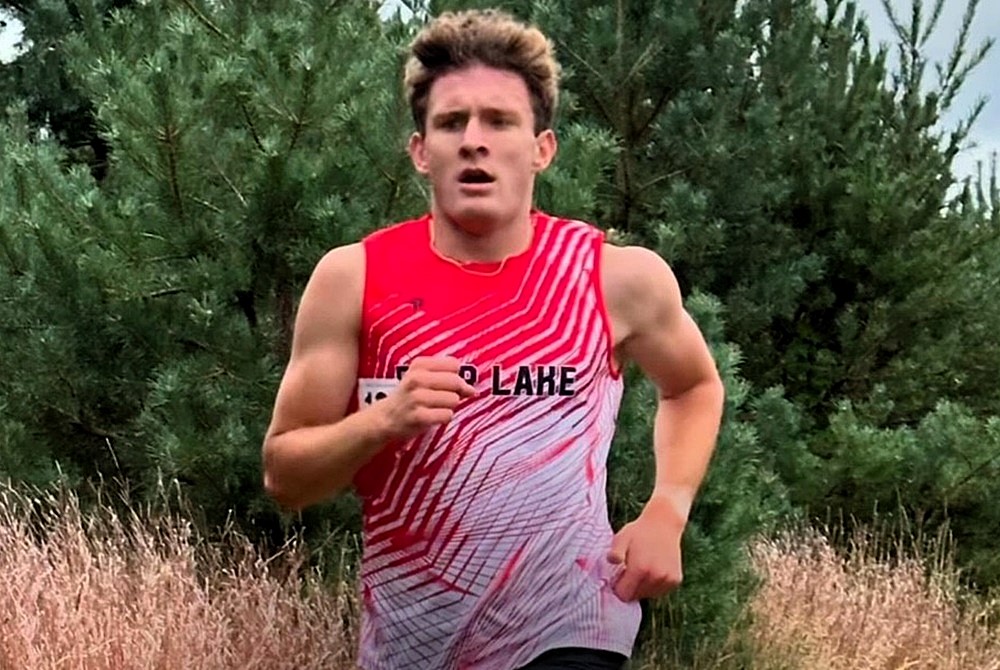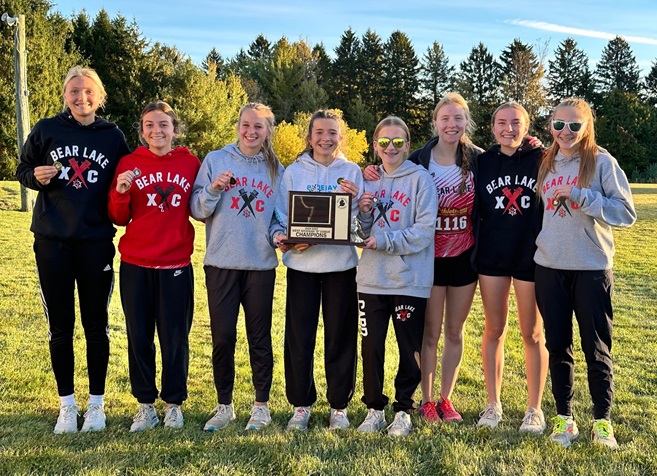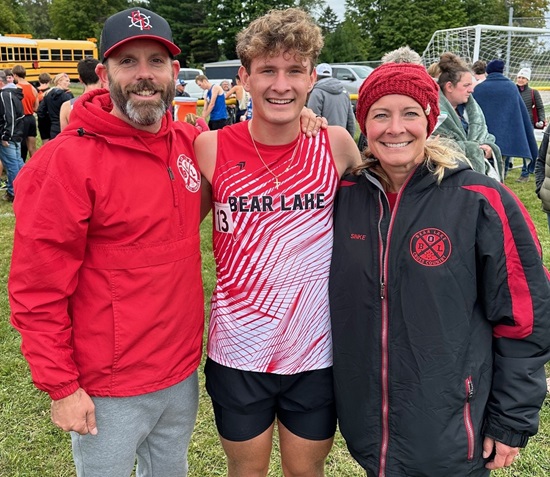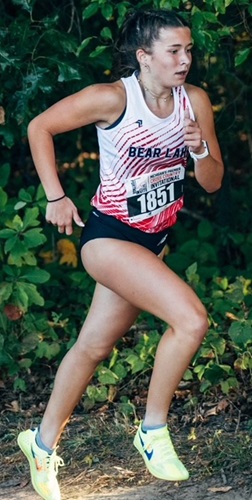
MHSAA Vault: MIS Rose to Challenges to Host 2020 LP Finals
By
Rob Kaminski
MHSAA benchmarks editor
November 12, 2021
The “MHSAA Vault” features stories from past publications and other documents in the MHSAA Library. This issue takes a look at the MHSAA Cross Country Finals at Michigan International Speedway, which celebrated 25 years in 2020 – although it was an event that nearly didn’t happen last fall …
In 1996, the MHSAA and Michigan International Speedway began a partnership the changed the course of the Lower Peninsula Cross Country Finals – quite literally.
The land in and around the track at Brooklyn would host the Finals for all classes of runners in one place on one day, an annual festival of nearly 2,000 runners competing for the MHSAA’s top honors.
Even skeptics – and there were several among running purists who thought the course was too flat, for example – can’t deny the results.
Finals attendance nearly doubled in that first year, and crowds in excess of 10,000 have enjoyed a day of racing several times, including a record 12,153 in 2011.
Enthusiastic crowds were the norm in recent years, with 11,232 in 2017, and nearly 11,000 in 2018 (10,989) and 2019 (10,873).
In fact, attendance failed to reach at least 8,000 only twice since the move to MIS.
Of course, last year was an exception, when attendance was limited to 1,000 spectators per session due to the COVID-19 Pandemic. Fans also were restricted to the grandstands rather than following the action throughout locations on the course.
To reduce the number of runners in each race, the event was spread over two days, with each Division being run in two separate “sections” with times then combined at the end to determine team and individual champions.
While not ideal, the end result was another year of fantastic efforts at MIS – both from student-athletes and those behind the scenes.
“Even at the last hour, less than a week ahead of the Finals, we were closer to not having the Finals than we were to having them,” said MHSAA Assistant Director Cody Inglis, who coordinates the cross country postseason. “Rumors and challenges of mandated shutdowns, testing and other requirements were being discussed and caused a lot of unknowns. Even at the Regional level, we had schools, Regional courses and hosts shutting down their facilities; we had to relocate four Regionals 48 hours prior to race times. That scenario just could not happen at the Finals level where far more runners and much more travel would be involved.”
Among the many last-minute hurdles was the edict from NASCAR – which owns MIS – that all persons on site be temperature checked upon entry. That meant securing thermometers that were easy to operate in short order, along with personnel necessary to conduct the readings.
The attendance limitations certainly helped to implement the temperature screening, but brought their own issues.
“Limiting spectators was not a popular decision, but it really was the only way to have a race,” Inglis said. “We were taking direction and working with policies and protocols from the MDHHS, the Governor’s office, Lenawee County Health Department, MIS and NASCAR.”
Part of the solution was to utilize the grandstands as a “barrier” between participants and spectators. The reduced number of fans were dispersed over thousands of seats while still allowing them the chance to watch their student-athletes compete.
“It wasn’t the same, it wasn’t easy or perfect, but it was what we had to do to have a race,” Inglis said. “Separating the Finals into two days and different sections also allowed us to spread out the event and limit the number of people on site at any one time. This was a key part of the plan and worked well even though it separated races within a Division.”
The MHSAA, MIS and the cross country community never lost focus of the main goal: a culmination of the season for the student-athletes, who deserved something last year more than ever. And, more than ever, MIS once again displayed its advantage as a venue that could adapt to the fluid nature of the times to pull off the event.
“There were some thoughts of using four different sites, but as we learned during the Regionals, the climate of things was so tenuous from one area of the state to another that we couldn’t be 100-percent certain that there wouldn’t again be last-minute cancelations,” Inglis said. “MIS was wonderful to work and collaborate with, and was the best option to get it done. It was never mentioned once publicly about the possibility of not having the Finals – only how we could best do it under uncharted conditions.”
The moving parts and ever-changing scenarios created more complexity than ever in finalizing a season, but every decision was made with the complete desire to conduct the Finals as close to normal as possible.
“I firmly believe that a finish to the season, no matter the differences in race formatting and fan experience, was something everyone would have taken when the season began in August,” Inglis said.
Indeed, the finish line in Year 25 at MIS might have been the most gratifying of them all.

Sinke Family Has Bear Lake Primed to Compete for Championships Now, In Future
By
Tom Spencer
Special for MHSAA.com
October 25, 2024
One Sinke is nearing the end of a high school running career seeking to qualify for a fourth-straight MHSAA Lower Peninsula Division 4 Cross Country Final.
 A few other Sinkes are right in the middle of possible team and individual title opportunities.
A few other Sinkes are right in the middle of possible team and individual title opportunities.
Mason Sinke, who broke the Bear Lake cross country race record earlier this season, is about to finish his stellar career on 5K courses. He still has the spring track season ahead, and then he’s moving on to run for Hope College. Saturday, he hopes — or rather expects — to qualify for his fourth Final while vying for the individual Regional title at Benzie Central.
His team will not qualify for the Final due to an insufficient number of healthy runners. But the Bear Lake girls team – led by freshman Callie Sinke – has its eyes on qualifying for the Final and can’t help but think a state championship is obtainable in the near future.
A future boys title also isn’t out of the question as the Lakers have a strong middle school program as well. The middle school’s current number one runner is Johnny Sinke.
And all the Lakers cross country teams are coached by Tony Shrum and Kim Sinke. Shrum has headed up the cross country program, which co-ops with Onekama, since 2012. Kim Sinke, a former college distance runner, joined the staff this year. She is also the mother of Mason, Callie and Johnny Sinke.
 Bear Lake is really hoping to start some strong winning streaks this weekend after long Regional championship streaks were common up until a decade ago. The Lakers are not unfamiliar with Finals appearances, but they’re looking for their first in a decade with the Regional trophy earned.
Bear Lake is really hoping to start some strong winning streaks this weekend after long Regional championship streaks were common up until a decade ago. The Lakers are not unfamiliar with Finals appearances, but they’re looking for their first in a decade with the Regional trophy earned.
“For the girls, as long as we’ve got everybody healthy and racing, the goal is to win,” Shrum said of the upcoming Regional. “It would be our seventh girls Regional title in the program’s history, so they would be on a list with a pretty exclusive group.”
Shrum hopes the resting and recovering this week will allow the Lakers to put their best foot forward in the Regional. Bear Lake’s girls, the West Michigan D League champions this year, will be racing against some familiar foes.
There will be disappointment if there aren’t several Lakers listed among the top 10 finishers – and a handful in the top five are pretty much expected.
Callie Sinke, who is fighting through normal running injury challenges, and Addy Zeller are the Lakers’ top two runners and arguably the top two rated runners in the region. But injuries have slowed down the top two Lakers a bit.
“Right now Callie is about 20 seconds ahead of everybody in the field Saturday,” Shrum pointed out. “We have three of the top five girls when healthy in the region, and our fourth girl has top-15 ability and our fifth girl has been coming on.”
And these Lakers are young. Callie Sinke is a freshman and Zeller, hampered lately by a quad injury, is a sophomore. Melodie Hulinek, the number three runner who is coming back from a knee injury, is also a freshman. Natalie Brown, the current fourth runner, is a junior. Two other freshmen, Isabella Card and Peyton Buckner, may run for the fifth scoring spot, along with two other juniors, Lauren Pulido-Huber and Libby Daugherty. The co-op is without a senior on the girls side.
 Shrum is excited about the opportunity this year and really the next three. He notes two current middle school runners will likely compete for varsity spots next fall.
Shrum is excited about the opportunity this year and really the next three. He notes two current middle school runners will likely compete for varsity spots next fall.
“We’ve got a good core of girls coming back for the next four years,” Scrum said.
Zeller and Sinke attend Onekama High School. The rest of the girls team are enrolled with Bear Lake.
Mason Sinke is a senior at Onekama. He too has sat out a few races recently to rest and prepare for his last two career high school meets.
All season, he’s had a special partner and coach, Kaden Forward. The school record Sinke broke this year had belonged to Forward, who finished 13th in last year’s Final. Sinke was a few seconds behind Forward in the Final last year and finished 16th. He’s looking to take one of the top spots – if not first place – this Saturday and go on to a top 10, if not top five, at the Final.
The West Michigan D League features one of the top runners in the state in Alex Tyndall from Mason County Eastern. Tyndall finished 18th in last year’s Final, a few seconds behind Sinke. Tyndall and Eastern will be among many competitors Bear Lake has raced against week after week. A handful of other runners familiar to Mason Sinke will challenge him for a top-five Regional finish.
“Right now Mason would be the number two guy behind Alex coming in,” Shrum acknowledged. “We’ll see if he wants to chase Alex and push him and see if he can take Alex down. but otherwise I think silver at the Regional is a definite possibility for him.”
 The Bear Lake boys team has no chance of qualifying for the Finals as two of its five team members are out with injuries. But Shrum holds strong hopes senior Greyson Hoeflinger will also qualify for the Finals as an individual.
The Bear Lake boys team has no chance of qualifying for the Finals as two of its five team members are out with injuries. But Shrum holds strong hopes senior Greyson Hoeflinger will also qualify for the Finals as an individual.
Over the 35 years of the co-op’s existence, Bear Lake’s boys teams have won 23 Regional titles and the girls have won six.
“Between Mason and Kaden, they have really changed the mindset of our program,” Shrum said. “Callie is leading the girls on the same path.”
Bear Lake is looking forward to an influx of talented young runners on the boys side too.
“Our next set of boys teams could be banner raising, winning teams of the state final,” Shrum predicted. “We’re on the comeback collectively as a program.”
The future is bright, but the current boys and girls teams members should get the credit for getting Bear Lake back to its winning ways.
“To me it is exciting to get back on that level and compete for state titles and Regional championships in the next five, six years,” Shrum noted. “A lot of it really has to do with the current group of kids that we have and their dedication, their discipline, their excitement and enthusiasm for the sport.”
 Tom Spencer is a longtime MHSAA-registered basketball and soccer official, and former softball and baseball official, and he also has coached in the northern Lower Peninsula area. He previously has written for the Saginaw News, Bay County Sports Page and Midland Daily News. He can be reached at [email protected] with story ideas for Manistee, Wexford, Missaukee, Roscommon, Ogemaw, Iosco, Alcona, Oscoda, Crawford, Kalkaska, Grand Traverse, Benzie, Leelanau, Antrim, Otsego, Montmorency, Alpena, Presque Isle, Cheboygan, Charlevoix and Emmet counties.
Tom Spencer is a longtime MHSAA-registered basketball and soccer official, and former softball and baseball official, and he also has coached in the northern Lower Peninsula area. He previously has written for the Saginaw News, Bay County Sports Page and Midland Daily News. He can be reached at [email protected] with story ideas for Manistee, Wexford, Missaukee, Roscommon, Ogemaw, Iosco, Alcona, Oscoda, Crawford, Kalkaska, Grand Traverse, Benzie, Leelanau, Antrim, Otsego, Montmorency, Alpena, Presque Isle, Cheboygan, Charlevoix and Emmet counties.
PHOTOS (Top) Mason Sinke runs to his school record-setting 5K time Sept. 7 at the Bear Country Invitational. (2) The Bear Lake girls team take a trophy photo after clinching the West Michigan D League title. (3) Mason Sinke, middle, takes a photo with Bear Lake head coach Tony Shrum and assistant and mother Kim Sinke. (4) Callie Sinke runs a race this fall. (Photos courtesy of the Sinke family.)

